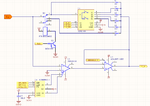ozcanay
Newbie level 6

Understanding LC Meter
Hi,
I am currently working about creating a LC Meter. I have come across with this project on the internet :
https://electronics-diy.com/lc_meter.php
And the same project a little bit twisted and with some explanations included :
**broken link removed**
I am just interested about the components around LM311. I guess I understood the purpose of those 100k resistors around the (+) pin of LM311 Opamp. Sort of changing voltage between 2VD/3 and VD/3 as explained here :
https://www.romanblack.com/onesec/CapMeter.htm
That relatively large 10uF capacitor is placed there for decoupling purposes I guess. I am aware of the fact that comparator outputs 1 or 0 (0v or 5V in this case) depending on the magnitude of the values on (+) and (-) pins. I figured out well how the calibration is done, and how capacitor and inductance values measured with f1 and f2 values known. But the things is I was not able to understand how f1 and f2 values are measured. I actually know that they are measured by looking at the comparator output period. However I don't know how comparator output is shaped up like that. Also I don't know the purpose of 10uF and 47k at the (-) pin of LM311
Thanks for all the help in advance.
Hi,
I am currently working about creating a LC Meter. I have come across with this project on the internet :
https://electronics-diy.com/lc_meter.php
And the same project a little bit twisted and with some explanations included :
**broken link removed**
I am just interested about the components around LM311. I guess I understood the purpose of those 100k resistors around the (+) pin of LM311 Opamp. Sort of changing voltage between 2VD/3 and VD/3 as explained here :
https://www.romanblack.com/onesec/CapMeter.htm
That relatively large 10uF capacitor is placed there for decoupling purposes I guess. I am aware of the fact that comparator outputs 1 or 0 (0v or 5V in this case) depending on the magnitude of the values on (+) and (-) pins. I figured out well how the calibration is done, and how capacitor and inductance values measured with f1 and f2 values known. But the things is I was not able to understand how f1 and f2 values are measured. I actually know that they are measured by looking at the comparator output period. However I don't know how comparator output is shaped up like that. Also I don't know the purpose of 10uF and 47k at the (-) pin of LM311
Thanks for all the help in advance.







